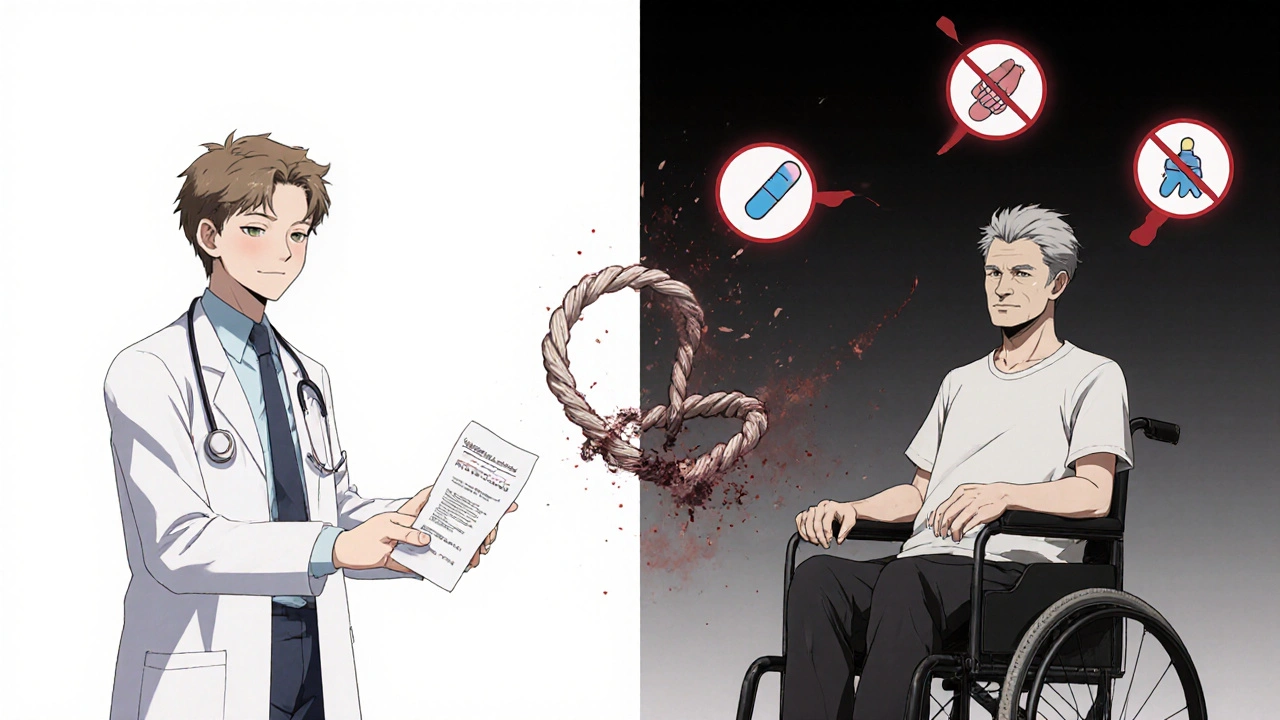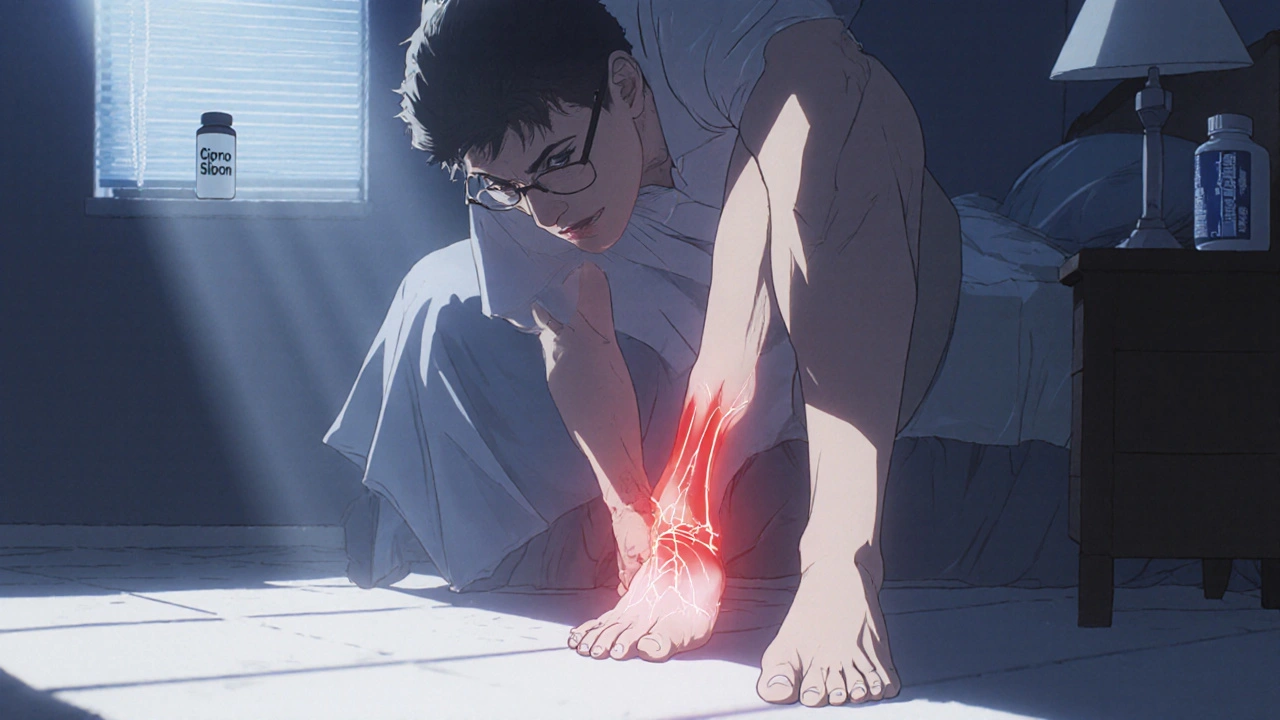Fluoroquinolone Risk Calculator
Important Information
This calculator uses FDA-reported data to estimate your risk of tendon rupture from fluoroquinolone antibiotics. Results are simplified and should NOT replace professional medical advice.
Based on FDA data:
- General tendon rupture risk: 0.108%
- Age >60: 3x higher risk
- Corticosteroids: 46x higher risk
When you take an antibiotic like ciprofloxacin or levofloxacin for a sinus infection or urinary tract infection, you expect to feel better. You don’t expect to wake up one morning with sudden, sharp pain in your heel-so bad you can’t stand on it. Or to feel your feet going numb, like they’re wrapped in electric wires. These aren’t rare nightmares. They’re real, documented risks tied to a class of antibiotics called fluoroquinolones.
What Are Fluoroquinolones, and Why Are They Still Prescribed?
Fluoroquinolones are powerful antibiotics that kill a wide range of bacteria. Drugs like ciprofloxacin, levofloxacin, and moxifloxacin were once go-to choices for everything from pneumonia to traveler’s diarrhea. They work fast, penetrate deep into tissues, and are often used when other antibiotics fail. But their use has changed dramatically since 2008. That’s when the U.S. Food and Drug Administration (FDA) added a black-box warning-the strongest possible-to all fluoroquinolones. By 2016, the FDA made it clear: these drugs should only be used when there’s no other option. The European Medicines Agency (EMA), Australia’s Therapeutic Goods Administration (TGA), and the UK’s MHRA followed suit. Today, fluoroquinolones are no longer first-line treatment for common infections like bronchitis, simple UTIs, or sinus infections. They’re still used-but only for serious, life-threatening infections: complicated kidney infections, hospital-acquired pneumonia, anthrax exposure, or when bacteria are resistant to every other drug. The trade-off? You’re trading a quick fix for a risk that could last years.Tendinopathy: More Than Just a Sore Tendon
The most feared side effect of fluoroquinolones is tendinopathy. This isn’t just mild soreness. It’s inflammation, degeneration, and sometimes complete rupture of tendons. The Achilles tendon-the thick band connecting your calf to your heel-is hit hardest. In fact, 89.8% of all fluoroquinolone-related tendon injuries involve the Achilles. Symptoms can show up as early as two days after starting the drug-or as late as six months after you’ve finished it. That’s the scary part: you might feel fine after your 7-day course, then suddenly collapse while walking, with no warning. Up to half of all tendon injuries happen after the antibiotic is gone. Studies show:- Between 0.14% and 0.4% of people taking fluoroquinolones develop tendinopathy.
- 40% of those cases end in tendon rupture.
- Up to 50% of patients experience symptoms in both tendons at once.
- People over 60 are nearly three times more likely to suffer a rupture.
- If you’re also taking steroids-like prednisone-the risk of rupture jumps 46-fold.
Nerve Damage: The Invisible Injury
While tendon damage is visible and painful, nerve damage is quieter-and often ignored. Fluoroquinolones can cause peripheral neuropathy: damage to the nerves in your hands, feet, arms, or legs. Symptoms include:- Burning, tingling, or prickling sensations
- Loss of feeling or numbness
- Weakness in limbs
- Sharp, shooting pains
Who’s Most at Risk?
Not everyone who takes a fluoroquinolone will have problems. But certain people are far more vulnerable:- Age 60 and older
- People taking corticosteroids (even short-term)
- Those with kidney disease
- Diabetics
- People who’ve had a prior tendon injury or rupture
- Organ transplant recipients
- People on long-term or high-dose fluoroquinolone therapy

What Happens When You Take One Anyway?
Many patients don’t realize they’re being prescribed a fluoroquinolone until it’s too late. Ciprofloxacin is still sold under brand names like Cipro, and levofloxacin as Levaquin. Pharmacists might not flag it. Doctors might assume you know the risks. If you’re prescribed one:- Ask: "Is this absolutely necessary? Are there safer alternatives?"
- Read the medication guide. It’s required by law to warn about tendon and nerve damage.
- Stop taking it immediately if you feel any tendon pain, swelling, or stiffness-even if it’s mild.
- Never take steroids while on these drugs.
- Don’t push through pain. Rest the affected area. Ice it. Get it checked.
Why Are These Risks Still Underreported?
The data is clear. But the real-world impact is even worse than the numbers suggest. Patient support groups like Floxie Australia (with over 1,200 members) and Reddit’s r/floxing (14,200 members) are full of stories: people who were healthy one day, then suddenly couldn’t walk, climb stairs, or hold a coffee cup. Many describe feeling abandoned by the medical system-doctors who didn’t believe them, dismissed their pain, or blamed them for being "overly sensitive." On Drugs.com, ciprofloxacin has a 2.2 out of 5 rating. Sixty-eight percent of negative reviews mention tendon or nerve damage. The Fluoroquinolone Effects Research Foundation has collected over 8,500 patient reports. Seventy-eight percent report tendon issues. The median symptom duration? Fourteen months. These aren’t outliers. They’re a pattern.What’s Being Done Now?
Regulators are catching up. In 2023, the FDA launched its Sentinel Initiative to track fluoroquinolone side effects in real time across 150 million Americans. The EMA confirmed the 4.1-fold increased risk of Achilles rupture in a 2023 post-authorization study. Prescribing has dropped sharply. In the U.S., fluoroquinolone use for simple UTIs fell from 17.3% in 2015 to just 5.1% in 2022. Across Europe, community prescriptions dropped 41% after the 2019 restrictions. But the damage is already done. Thousands have been permanently affected. And new antibiotics are still years away.
What Are the Alternatives?
For most common infections, safer options exist:- Uncomplicated UTIs: Nitrofurantoin, fosfomycin, or trimethoprim-sulfamethoxazole
- Sinus infections: Amoxicillin, doxycycline, or watchful waiting
- Bronchitis: Usually no antibiotic needed-symptom management only
- Skin infections: Cephalexin, clindamycin, or doxycycline
What Should You Do If You’ve Already Taken One?
If you’ve taken ciprofloxacin, levofloxacin, or another fluoroquinolone in the past:- Monitor for delayed symptoms. Pain or numbness can appear months later.
- Keep a record of any new pain, weakness, or tingling.
- Don’t ignore symptoms just because you finished the pills.
- If you suspect tendon or nerve damage, see a doctor who understands fluoroquinolone toxicity. Physical therapy can help-but only if you stop the damage early.


Just had to share this - I took cipro for a UTI in 2020 and woke up three weeks later with a ruptured Achilles. No warning. No pain before. Just *snap*. Now I walk with a limp and my PT says it’s permanent. Docs told me it was "just aging." 😒 I’m lucky I didn’t end up in a wheelchair. If you’re prescribed a fluoroquinolone, ask for alternatives. Seriously. Your tendons will thank you. 🙏
Let’s be real - the FDA’s black-box warning came in 2008, but prescribing didn’t drop until 2019. That’s over a decade of avoidable damage. And the data? Underreported because most patients aren’t connected to support groups. The 8,500 reports? That’s the tip of the iceberg. Hospitals don’t track long-term tendon or neuropathy outcomes. Pharma doesn’t fund studies on adverse effects. It’s not negligence - it’s systemic profit protection.
So let me get this straight - you’re telling me a drug that’s been around for 40 years is suddenly dangerous? I’ve taken cipro like candy since college and I’m 52 and still running marathons. You people are just looking for reasons to panic. Maybe your tendon problems are from being couch potatoes and not stretching. Or maybe you’re just mad because Big Pharma didn’t give you a free spa day.
George, your comment is the textbook definition of toxic denial. Let’s unpack this: you’re not a statistical outlier - you’re a lucky one. And your marathons? They’re not proof of safety, they’re proof of survivorship bias. The 0.4% who rupture tendons aren’t the ones posting on Reddit - they’re the ones in wheelchairs, unable to tie their shoes. The FDA didn’t ban these drugs - they restricted them. That’s not panic. That’s responsibility. And if you think ‘stretching’ fixes nerve damage caused by mitochondrial toxicity, you haven’t read a single peer-reviewed paper on fluoroquinolone-induced oxidative stress. Please stop weaponizing anecdote against epidemiology.
It is imperative to note that the overwhelming majority of individuals who utilize fluoroquinolones do not experience adverse effects. The FDA’s warnings, while legally mandated, are often misinterpreted as absolute contraindications rather than risk mitigation advisories. Furthermore, the emotional testimonies cited in patient forums are not peer-reviewed data, and thus cannot be used to inform clinical guidelines. One must exercise caution against confirmation bias and anecdotal evidence inflation. I am a physician, and I have never seen a case of permanent neuropathy directly attributable to fluoroquinolone use in a patient without comorbidities.
Here’s the real question: who benefits from the fear? The FDA? The medical industry? Or the lawyers who file class actions against pharma? I’ve seen the data - fluoroquinolone prescriptions dropped 41% in Europe. But hospital admissions for tendon injuries? Didn’t drop. Why? Because they were already misdiagnosed as arthritis or overuse. The entire narrative is a manufactured crisis. And don’t even get me started on Reddit’s r/floxing - 14k members? That’s a cult. They don’t want to be cured. They want validation.
Okay but let’s not pretend this is new. I’ve been reading about this since 2012 when my cousin’s boyfriend got tendon rupture after a single dose of Levaquin and spent six months in physical therapy and then sued the hospital and then got a settlement and then started a YouTube channel called ‘Floxie Survivor’ and now he sells $40 ‘anti-floxie’ supplements made of turmeric and magnesium and claims it reverses nerve damage - which it doesn’t - and the FDA hasn’t approved any of it - and yet people still believe it because it’s easier than accepting that sometimes medicine is a gamble and your body just breaks and no one’s to blame except biology and capitalism and maybe your doctor who didn’t warn you because they were rushed and didn’t read the 17-page medication guide because they had five patients waiting and now you’re here reading this comment because you’re scared and you want someone to say ‘it’s not your fault’ - but it’s not anyone’s fault - it’s just the cost of modern medicine and if you’re lucky you’ll be one of the 99.6% who don’t end up crying in a physical therapy waiting room at 3am wondering if you’ll ever walk normally again.
Interesting how the narrative shifts from ‘life-saving drug’ to ‘toxic abomination’ based on social media outrage. The same people who scream about pharmaceutical malfeasance still take antidepressants, statins, and NSAIDs without a second thought. Fluoroquinolones are not unique in their risk profile - they’re just the latest scapegoat. The real issue is the erosion of medical autonomy. Patients are being conditioned to fear every prescription, while ignoring lifestyle factors, aging, and genetic predispositions. This isn’t science. It’s performative health anxiety.
I want to say thank you to the original poster. This is the kind of clear, compassionate, evidence-based breakdown we desperately need. I’m a nurse practitioner, and I’ve seen too many patients come in with tendon pain months after a simple UTI prescription - and their PCP says, ‘It’s probably just arthritis.’ I now have a printed handout I give every patient before I write any fluoroquinolone. I ask: ‘Have you ever had tendon issues? Are you on steroids? Do you know this could cause permanent nerve damage?’ Most say no. Then they cry. I don’t blame them. I blame the system that lets a 7-day pill become a lifetime sentence. If you’re reading this and you’re scared - you’re not alone. Find a specialist. Join a support group. Rest. Ice. Don’t push through. And if your doctor pushes back - get a second opinion. Your body isn’t a battleground. It’s your home.
i took cipro for a bladder infection and now my feet feel like theyre on fire all the time and my doctor said its just anxiety and i should stop googling. i dont know what to do anymore. i just want to walk without crying